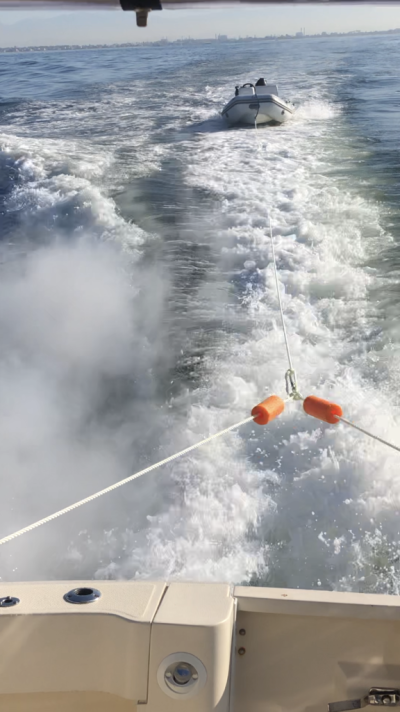The max fuel burn for a 210hp 5.9 cummins is 11.2 GPH This would be 100% load. Using 210hp/11.2 gpg = 18.75 hp per gallon burn. 100% load= 11.2 GPH, 80% load = 8.96 GPH. This would be the goal I would shoot for 80% load would be an efficient and maintain the longevity of the 5.9 L cummins
@210. 80% load would be using about 170 hp.
Based on your fuel burn 6.8 gph and 2400 rpm I believe you either have wrong fuel burn calculations or or you are under propped. Based on your max rpm posted on this forum 2650 rpm you would be correctly propped or slightly over propped. The rule of thumb is 100 to 150 rpm above rated HP RPM which is 220@ 2600 rpm.
My guess would be your fuel burn numbers are a bit off. Using 12Kts = 13.8mph as an average speed at 2400 rpm @ 6.8 GPH would give you fuel economy of 2.03 mpg. 2400 rpm @ 8.96 gph ( my calculation)= 1.54 mpg which I believe is a true realistic number for continuous run at 2400 rpm. I do believe that if you cruise at 2400 rpm for a trip you may see that your overall fuel burn may be 6.8 gph if you add the engine hours of the trip to fuel burn amount. Example: Start engine hour meter running, untie, leave harbor, allow engine to get up to temp, start to advance throttle, set cruise at 2400 rpm, slow for a few no wake areas..... you get the drift! Your overall fuel burn may be 6.8 gph. The best way to get true fuel burn for speed. Distance traveled divided by Engine hours ( start engine shut engine off) = average speed. Fuel used divided by average speed = mpg for that average mph Now you know mpg for a specific speed. Advance the boat to that speed and compare Speed to RPM.
Example: @ 9mph the fuel economy is 2.5mpg. Throttle the boat to 9 mph. what rpm is the engine running 1800 rpm ( hypothetical #) = 1800 rpm =2.5mpg , 9 miles in one hour divided by 2.5 mpg = 3.6 gph @ 1800 rpm this is not referring to fuel burn of the 210 cummins. Just an example.
This is a lot of information that most could careless, I know! But it is a good way to know accurate average fuel burn and know that your engine is maintaining it. You have a base line. When it comes to decided you have the right prop. The engine manufactures did that homework for you. The engine manufactures give you a max rpm for rated HP. The manufacture says the engine/boat is propped correctly if the engine can turn the max rpm preferably +150 rpm @ WOT. 210 Cummins anything above 2600 rpm when operated with full load and fuel. The boat and engine are propped correctly.
 , but it has gotten me wondering at what other Pilot owners are running their boats at. At 2400 rpm (WOT is 2650), I am cruising in the 11- 12.3 kts range ( yes I have seen higher up to 15 kts, but not very often). I do like to throttle back and cruise in the 9-10 kts range. I realize that this Cummins, a very reliable engine, is probably the smallest hp engine for the pilots and that later iterations with the Yanmar had a bunch more HP. So I would love to know if other Pilot owners with this model engine are seeing similar speeds? More curious than concerned -
, but it has gotten me wondering at what other Pilot owners are running their boats at. At 2400 rpm (WOT is 2650), I am cruising in the 11- 12.3 kts range ( yes I have seen higher up to 15 kts, but not very often). I do like to throttle back and cruise in the 9-10 kts range. I realize that this Cummins, a very reliable engine, is probably the smallest hp engine for the pilots and that later iterations with the Yanmar had a bunch more HP. So I would love to know if other Pilot owners with this model engine are seeing similar speeds? More curious than concerned -
